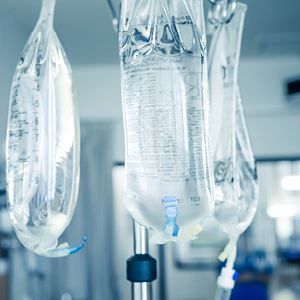
Medical
For more than 50 years, PVC/vinyl’s performance and protectiveness have made it a critical material in such health care products and procedures as blood and intravenous bags, kidney dialysis and blood transfusions, cardiac catheters and endotracheal tubes. These products are regulated for safety by the U.S. Food and Drug Administration (FDA).
Vinyl’s unique characteristics meet the health care industry’s tough performance standards while also being durable, easily sterilized and non-breakable. Indeed, no other material on the market performs as well or as cost effectively as vinyl.
Vinyl is used in hundreds of medical products and devices. In fact, 25 percent of all medical products containing plastic are made with vinyl, and even more applications are continually being developed.
Some of the most prevalent uses include:
Vinyl is used in hundreds of medical products and devices. In fact, 25 percent of all medical products containing plastic are made with vinyl, and even more applications are continually being developed.
Some of the most prevalent uses include:
Vinyl characteristics that make it uniquely suited to medical use:
- It is optically clearer than many alternatives.
- It is kink-resistant. Alternatives frequently kink when bent to angles of 90 degrees or more, which can cut off the flow of blood or vital fluids to a patient if left undetected for any length of time.
- It resists “necking down” – that is, constricting when pulled. Vinyl alternatives can neck down when inadvertently stretched, which can result in a changed inner tubing diameter that affects the fluid delivery rate.
- Medical kits made of vinyl are factory assembled using a technique known as solvent cementing, in which tubing is locked to its connectors and ports by a solvent that evaporates after application. Most PVC substitutes cannot be bonded this way. If joints yank loose and leaks occur, patients can be exposed to flow interruptions, and caregivers can be exposed to potentially contagious body fluids.
- Vinyl medical products can also be steam-sterilized and frozen. And, they are tough enough to be air-dropped onto a battlefield for use by troops on the move.
Plasticizers
Flexibility is a key performance attribute of vinyl medical products, requiring the use of a plasticizer. Di(2-ethylhexyl) phthalate (DEHP) is the plasticizer most often used (although not the only one available) to make vinyl flexible. DEHP allows vinyl to be softened and shaped into many designs without cracking or leaking. Without plasticizers such as DEHP, many of the vinyl medical products doctors and nurses use every day would not exist.
Disposal
Vinyl medical products can be handled like other medical wastes at the end of their lives, whether that means sterilizing and landfill or incineration. If they are incinerated, vinyl products are not a unique source of dioxin, which can be created when most things burn, including wood, food and garbage as well as vinyl.
Dioxin is formed when chlorine or chlorides are present during combustion. Studies have shown that when burning is well controlled, as it is in modern incinerators, very little dioxin is made or emitted.
For example, a 1995 study sponsored by the American Society of Mechanical Engineers (ASME), involving the analysis of more than 1,900 test results from 169 large-scale commercial incinerator facilities throughout the world, found no relationship between the chlorine content of waste like vinyl and dioxin emissions from combustion processes under real-life conditions.
The amount of chlorine or vinyl going into the incinerator is not a reliable indicator of the amount of dioxin coming out. Rather, incinerator design and operation have far more important impacts. However, in uncontrolled burning (e.g., volcanoes, forest fires, old incinerators, backyard burn barrels and accidental building fires), dioxin can be formed in larger amounts.
The best news about dioxin is that emissions to the environment and levels in the environment have been declining for decades, according to the U.S. Environmental Protection Agency. This has happened even as vinyl production and use have soared.

